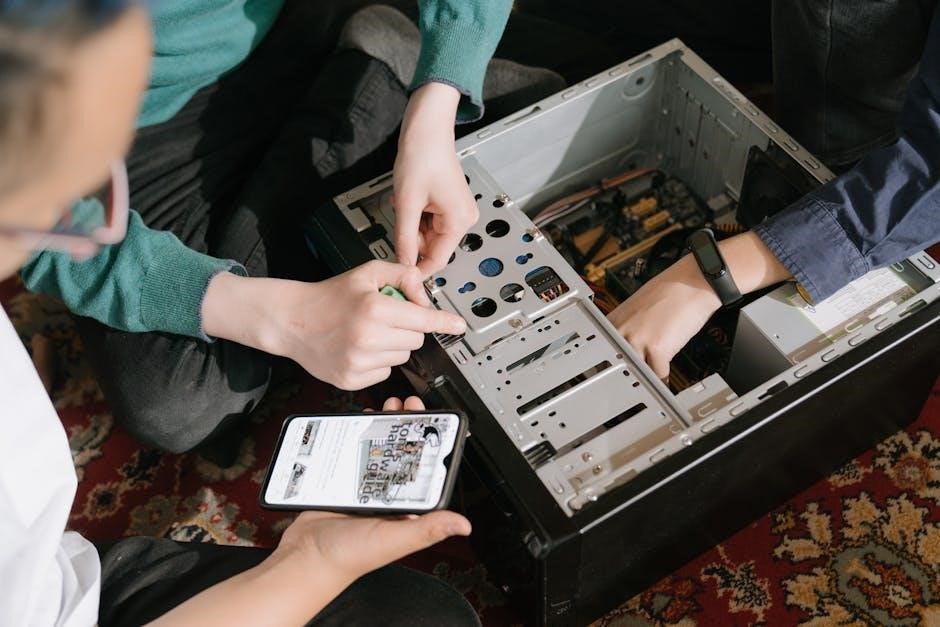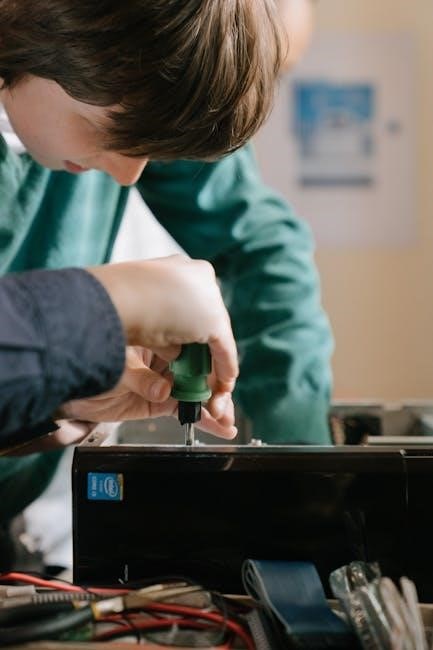No Heat
Your Roper dryer may not produce heat due to a faulty heating element, blown thermal fuse, or issues with the circuit board. Check these components first.
- Faulty heating element: Test continuity; replace if broken.
- Thermal fuse: Reset or replace if damaged.
- Circuit board: Inspect for burns or shorts.
1.1 Faulty Heating Element
A faulty heating element is a common cause of no heat in your Roper dryer. Over time, the element can crack or break, disrupting the heating cycle. To diagnose, inspect the element for visible damage or use a multimeter to test continuity. If faulty, replace it immediately. Ensure power is off before attempting repairs. A malfunctioning heating element can also lead to inconsistent drying or complete loss of heat. Always refer to your dryer’s model-specific manual for replacement steps to avoid further damage or safety hazards.
1.2 Thermal Fuse Issues
A blown thermal fuse is a common issue causing your Roper dryer to stop heating. The fuse, located near the heating element, acts as a safety feature to prevent overheating. If it blows, the dryer won’t produce heat. To resolve this, disconnect power, access the fuse, and test it with a multimeter for continuity. If faulty, replace it with a compatible part. Ensure the new fuse matches the specifications to avoid further issues. Always follow safety precautions when working with electrical components to prevent damage or injury. A blown thermal fuse requires immediate attention to restore heating functionality.
1.3 Circuit Board Problems
A faulty circuit board can prevent your Roper dryer from producing heat. Common signs include error codes on the display, the dryer not starting, or the heating element not activating. To diagnose, disconnect power and inspect the board for visible damage, such as burns or shorts. Use a multimeter to test for continuity in related circuits. If the board is damaged, it may need to be replaced. Ensure to purchase a compatible replacement part. In some cases, a malfunctioning circuit board can mimic other issues, so thorough testing is essential. Always prioritize safety when working with electrical components.
1.4 Door Switch Malfunction
A faulty door switch can prevent your Roper dryer from producing heat. The door switch ensures the dryer operates only when the door is closed. If the switch fails, the dryer may not start or heat. Common signs include the dryer stopping mid-cycle or failing to activate the heating element. To diagnose, test the switch for continuity using a multimeter. If it shows no continuity when the door is closed, the switch is faulty and needs replacement. A malfunctioning door switch is a common yet easily fixable issue. Always ensure the door aligns properly before testing the switch.
Won’t Start
Your Roper dryer may fail to start due to a faulty thermal fuse, door switch failure, or a broken drum belt; Check power supply and test components.
2.1 Thermal Fuse Failure
A failed thermal fuse is a common issue preventing your Roper dryer from starting. Located near the heating element, it blows when overheated. To diagnose, check for continuity using a multimeter. If faulty, replace it immediately. Ensure the dryer is unplugged before performing any repairs to avoid electrical hazards. A blown fuse may also indicate underlying issues like vent blockages or malfunctioning components. Always use genuine replacement parts to maintain safety and efficiency. Regular maintenance, like cleaning vents, can help prevent future fuse failures.
2.2 Door Switch Failure
A malfunctioning door switch can prevent your Roper dryer from starting. The door switch ensures the dryer operates only when the door is closed. If faulty, it may not send the proper signal to the control board. Test the switch for continuity using a multimeter. If it fails, replace it with a genuine part. A broken door switch is a common issue and can be resolved with basic tools. Always unplug the dryer before performing repairs to ensure safety; Regular inspection of the door switch can help prevent unexpected breakdowns and keep your dryer running smoothly.
2.3 Broken Drum Belt
A broken drum belt is a common reason your Roper dryer won’t start. The belt connects the motor to the drum, enabling rotation. If it snaps, the drum won’t spin; Inspect the belt for cracks or breaks. Replace it if damaged, ensuring proper alignment and tension. A faulty belt can also cause unusual noises. Use a genuine replacement part for reliability. Regular maintenance, like checking belt wear, can prevent sudden failures. Always unplug the dryer before performing repairs to stay safe. Replacing the drum belt is a straightforward fix that restores normal operation quickly and effectively.

Noisy Operation
A jammed blower wheel can cause noisy operation. Foreign objects or lint buildup obstruct airflow, leading to loud noises. Regular cleaning prevents such issues.
3.1 Jammed Blower Wheel
A jammed blower wheel is a common cause of noisy dryer operation. Lint buildup or foreign objects can obstruct the wheel, creating loud rattling or grinding sounds. To resolve this, shut off the dryer and unplug it for safety. Remove the lint filter and vacuum excess debris. Access the blower wheel housing by removing the lower panel or back cover. Inspect for blockages and clean thoroughly. Ensure all lint and obstructions are cleared before restarting the dryer. Regular maintenance prevents such issues and ensures smooth operation.
3.2 Worn Drum Bearings
Worn drum bearings can cause noisy operation, often resulting in grinding or screeching sounds during cycles. Over time, friction and heat degrade the bearings, leading to poor drum rotation and potential stoppage. Inspect the drum bearings for wear or damage. If faulty, replacement is necessary to restore smooth operation. Ensure proper installation to avoid further issues. Regular maintenance, such as cleaning and lubricating moving parts, can prevent premature bearing wear. Addressing this promptly avoids more severe damage and ensures efficient drying performance.
3.3 Faulty Motor
A faulty motor can lead to noisy operation, with symptoms like unusual humming, grinding, or failure to start. Overheating or excessive wear may cause motor failure. Inspect for signs of damage or blockages, such as a jammed blower wheel. Test the motor for continuity and ensure connections are secure. If the motor is damaged, replacement is necessary. A faulty motor can also cause the drum to stop spinning, affecting drying performance. Addressing this issue promptly prevents further damage and restores normal operation. Regular maintenance, like cleaning and lubricating, can help extend motor life and prevent premature failure.
Maintenance Tips

Regular maintenance ensures optimal performance. Clean the vent system annually, replace worn drum belts, and lubricate moving parts to prevent overheating and noisy operation.
- Clean vent system
- Replace drum belt
- Lubricate moving parts
4.1 Cleaning the Vent System
Cleaning the vent system is crucial for efficient dryer operation. Remove lint buildup from the venting to improve airflow and reduce fire risks. Use a vacuum or brush to clear blockages. Check the exterior vent for obstructions. Regular cleaning prevents overheating and ensures proper drying. Schedule this maintenance annually or after noticing reduced performance. A clean vent system enhances safety and extends the dryer’s lifespan. Always unplug the dryer before cleaning to avoid accidents. Proper ventilation ensures your Roper dryer runs smoothly and safely. Consistent maintenance prevents costly repairs and keeps your appliance functioning optimally for years.

4.2 Replacing the Drum Belt
A broken drum belt can cause the dryer to malfunction. To replace it, first unplug the dryer for safety. Remove the back panel to access the belt. Inspect the belt for cracks or wear and replace it with a genuine part, such as Roper’s OEM drum belt (part #4392065). Ensure the belt is properly aligned and tightened. Check the pulleys for obstructions or debris. Reassemble the dryer and test it to ensure smooth operation. Regularly inspecting the drum belt prevents unexpected breakdowns and extends the dryer’s lifespan. Proper installation ensures optimal performance and safety.
4.3 Lubricating Moving Parts
Lubricating moving parts is crucial for smooth dryer operation. Regularly grease the drum rollers, idler pulley, and tensioner to reduce friction and noise. Use high-temperature silicone-based lubricant to prevent wear. Inspect and clean parts before applying lubricant to ensure effectiveness. Avoid over-lubrication, as it can attract dust and cause issues. Lubricate every 6-12 months or when you notice increased noise. Proper lubrication extends the lifespan of moving components and prevents premature failure. Always unplug the dryer before performing maintenance to ensure safety. This simple step helps maintain efficiency and reduces the risk of costly repairs. Regular lubrication is key to optimal performance.

DIY Repair Guidance
Start with safety precautions, then use diagnostic tools to identify issues. Follow step-by-step guides for part replacements to ensure repairs are done correctly and safely.
5.1 Safety Precautions
Always disconnect power before starting repairs. Wear protective gloves and eyewear. Ensure proper ventilation and avoid sparks near flammable materials. Use authorized tools to prevent damage. Never bypass safety features like thermal fuses or door switches. If unsure, consult a professional. Ground yourself to prevent static discharge. Keep children away from the work area. Double-check all connections before restoring power. For gas dryers, ensure the gas supply is off and lines are secure. Follow manufacturer guidelines to avoid voiding warranties or causing further issues. Safety should always be your top priority when performing DIY repairs.
5.2 Diagnostic Tools and Techniques
Use a multimeter to test electrical components like fuses, heating elements, and switches. Inspect belts and bearings visually for wear. Check for voltage at terminals using a voltage tester. Consult repair manuals for specific diagnostic procedures. Listen for unusual noises to identify faulty parts. Use a continuity test on thermal fuses and door switches. Inspect venting systems for blockages. Employ a process of elimination to isolate issues. Always refer to the user manual for model-specific guidance. These tools and techniques help pinpoint problems accurately and efficiently, ensuring effective repairs.
5.3 Step-by-Step Part Replacement
Start by unplugging the dryer to ensure safety. Remove the top or back panel to access internal components. Replace faulty parts like heating elements or thermal fuses by disconnecting wires and sliding out the old part. For drum belts, loosen the tensioner and pull the belt off the pulleys. Reassemble in reverse order, ensuring proper alignment. Test the dryer after replacement to confirm functionality. Always refer to the user manual for specific instructions tailored to your model. Proper part replacement ensures optimal performance and safety. Dispose of old parts responsibly.
